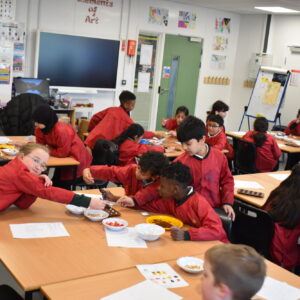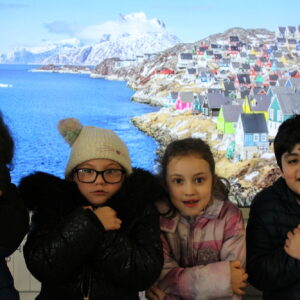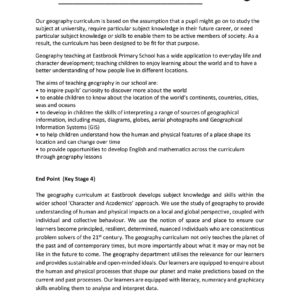At Eastbrook Primary School, Geography education is fully inclusive to every child. Our aims are to fulfil the requirements of the National Curriculum for Geography; providing a broad, balanced and differentiated curriculum; ensuring the progressive development of geographical concepts, knowledge and skills; and for the children to develop a love for geography. Furthermore, we aim to inspire in pupils a sense of perspective, social intelligence, appreciation, curiosity and fascination about the world and its people that will remain with them for the rest of their lives. Teaching will equip pupils with knowledge about diverse places, people, resources as well as natural and human environments, together with a deep understanding of the Earth’s key physical and human processes. (Primary National Curriculum in England 2014)
Geography teaching at Eastbrook Primary School has a wide application to everyday life and character development; teaching children to enjoy learning about the world and to have a better understanding of how people live in different locations.
The aims of teaching geography in our school are:
- to inspire pupils’ curiosity to discover more about the world
- to enable children to know about the location of the world’s continents, countries, cities, seas and oceans
- to develop in children the skills of interpreting a range of sources of geographical information, including maps, diagrams, globes, aerial photographs and Geographical Information Systems (GIS)
- to help children understand how the human and physical features of a place shape its location and can change over time
- to provide opportunities to develop English and mathematics across the curriculum through geography lessons
EYFS
Geography is taught in reception as an integral part of the topic work covered during the year through the International Primary Curriculum (IPC). We relate the geographical aspects of the children’s work to the objectives set out in the Early Years curriculum which underpin the planning for children aged three to five. Geography makes a significant contribution to the ELG objectives of developing a child’s understanding of the world through activities such as finding out about different places and habitats and investigating our locality.
Key Stage 1
During Key Stage 1, pupils investigate their local area and a contrasting area in the United Kingdom or abroad, finding out about the environment in both areas and the people who live there. They also begin to learn about the wider world. They carry out geographical enquiry inside and outside the classroom. In doing this, they ask geographical questions about people, places and environments, and use geographical skills and resources, such as maps and photographs.
Key Stage 2
During Key Stage 2, pupils investigate a variety of people, places and environments in the United Kingdom and abroad, and start to make links between different places in the world. They find out how people affect the environment and how they are affected by it. Pupils carry out geographical enquiry inside and outside the classroom. In doing this, they ask geographical questions, and use geographical skills and resources, such as maps, atlases, aerial photographs and ICT. Children will develop geographical enquiry skills, including asking geographical questions, collecting and recording information and identifying different views. They will acquire the appropriate practical skills associated with Geography, including using suitable vocabulary, fieldwork techniques and maps, plans and atlases. Pupils will use secondary sources of information with accuracy, including aerial photographs, satellite images, etc.







